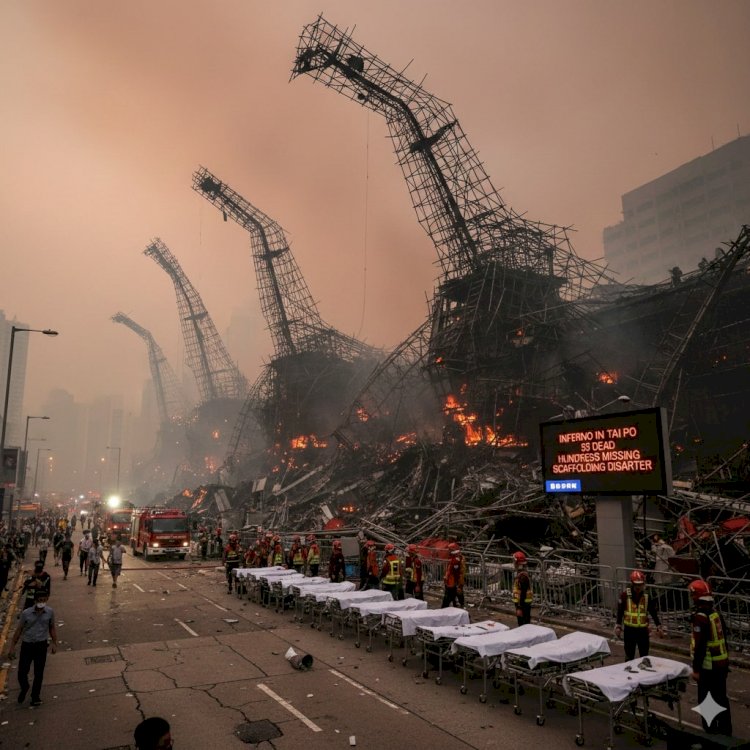Inferno in Tai Po: Hong Kong's Deadliest Blaze Claims 55 Lives, Hundreds Missing in Scaffolding Nightmare

Flames that leaped like vengeful spirits consumed the night sky over Hong Kong's northern Tai Po district on November 26, 2025, turning the Wang Fuk Court housing estate—a labyrinth of 31-story towers sheltering thousands—into a towering inferno that has seared itself into the city's collective trauma. By Thursday morning, the death toll had surged to at least 55, with 279 residents still unaccounted for amid the charred wreckage, marking the worst fire in Hong Kong since World War II. As firefighters battled acrid smoke and blistering heat for over 24 hours, authorities arrested three individuals linked to a "grossly negligent" construction firm, igniting a furious probe into why flammable bamboo scaffolding and substandard mesh—outlawed in public projects just months prior—were allowed to encase these public homes.
The Spark That Swallowed a Skyline: From Scaffolding Slip to Catastrophic Spread
It began innocuously enough, or so it seemed: at 2:52 p.m. on Wednesday, a routine spark—possibly electrical, per early whispers—ignited the external bamboo scaffolding on Wang Cheong House, one of eight interconnected towers in the densely packed Wang Fuk Court complex. What followed was a horror show of rapid escalation. Flammable green construction mesh, laced with Styrofoam insulation on windows and walls, acted as accelerant, propelling the blaze across seven buildings in minutes. Bamboo poles, a hallmark of Hong Kong's traditional high-rise retrofits, crackled and collapsed, raining fiery debris onto escape routes below.
Eyewitnesses recounted pandemonium: residents like 71-year-old Wong, watching helplessly from a nearby hill, screamed for his wife trapped on the 22nd floor. "The flames crawled up like snakes, and the smoke—it was blacker than night," he told reporters, his voice cracking as sirens wailed. Fire Services Department deputy director Derek Armstrong Chan described a "level 5" inferno—the highest alert—fueled by temperatures exceeding 1,000 degrees Celsius, warping steel and sealing upper floors like tombs. Over 140 fire engines and 60 ambulances swarmed the site, but falling embers and extreme heat thwarted access to the top levels, where many perished in smoke-choked stairwells.
By dawn Thursday, the blaze was "under control" in four towers, but hotspots smoldered in the rest. At least 66 were hospitalized, 17 in critical condition from burns and inhalation injuries. The Indonesian consulate confirmed two domestic workers among the dead, while families gathered at temporary shelters in community centers, clutching photos of the missing amid the acrid haze.
Bamboo's Bitter Legacy: A Phased-Out Peril That Proved Deadly
Hong Kong, a skyline of gleaming towers built on reclaimed land, prides itself on stringent safety codes—yet this tragedy exposes a glaring loophole. Bamboo scaffolding, prized for its flexibility in the city's cramped verticality, has been a construction staple despite mounting warnings. The government announced a phase-out for public projects in March 2025 after 22 scaffolder deaths between 2019 and 2024, but private retrofits like Wang Fuk Court's—ongoing since summer—slipped through. Police suspect the mesh and Styrofoam, installed by a now-scrutinized firm, failed fire-resistance tests, turning maintenance work into a deathtrap.
"This was grossly negligent," Fire Services Commissioner Poon Kwok-wai thundered at a presser, vowing a "zero-tolerance" overhaul. Three arrests—linked to the contractor—followed swiftly, with investigations probing if cost-cutting trumped compliance. Advocacy group the Association for the Rights of Industrial Accident Victims decried it as "foreseeable folly," citing similar scaffolding blazes in April, May, and October. Chief Executive John Lee, face ashen in a rare emotional address, pledged "every effort" to extinguish the flames and "sympathies to the bereaved," ordering a full audit of 1,200 ongoing projects citywide.
Echoes of Tragedy: Hong Kong's Fiery Ghosts and a City's Reckoning
This catastrophe eclipses modern horrors: the 1996 Kowloon blaze that claimed 41 lives in a commercial tower, or the 1962 Sham Shui Po tenement fire that killed 44. Pre-WWII, Japanese occupation fires razed districts, but none matched Wang Fuk's scale in a peacetime metropolis of 7.5 million. Survivors' tales pierce the statistics: a mother clutching her infant, windows sealed against renovation dust, unheard alarms drowned by the roar; an elderly couple, windows barred for "safety," asphyxiated in their high-rise cage.
As rescuers combed debris Thursday—drones capturing drone views of twisted girders and soot-blackened facades—questions mounted. Why no sprinklers in scaffolds? How did alarms fail? Xi Jinping, from Beijing, urged "utmost efforts," but locals seethe at a system strained by density and deregulation. "We're stacked like kindling," lamented one evacuee, wrapped in a foil blanket at a school shelter.
Dawn of the Aftermath: Probes, Pledges, and a Push for Prevention
By midday November 27, the fire's fury ebbed, but the human toll loomed. With 279 missing—many elderly or migrant workers—DNA teams braced for grim identifications. Hospital wards overflowed with the burned and broken, while psychologists fanned out to trauma centers. Lee vowed compensation from a $100 million relief fund, but grief's currency is colder: families like Wong's, staring at empty chairs.
The blaze demands more than tears—a reckoning with Hong Kong's vertical vulnerability. As bamboo's embers cool, calls crescendo for mandatory retrofits, AI-monitored alarms, and scaffold bans citywide. In a global city of glass and steel, Wang Fuk's scars remind: progress's price, unpaid, exacts the ultimate toll. For Tai Po's survivors, the flames fade, but the fight for safer skies endures.

 content-team
content-team 


















